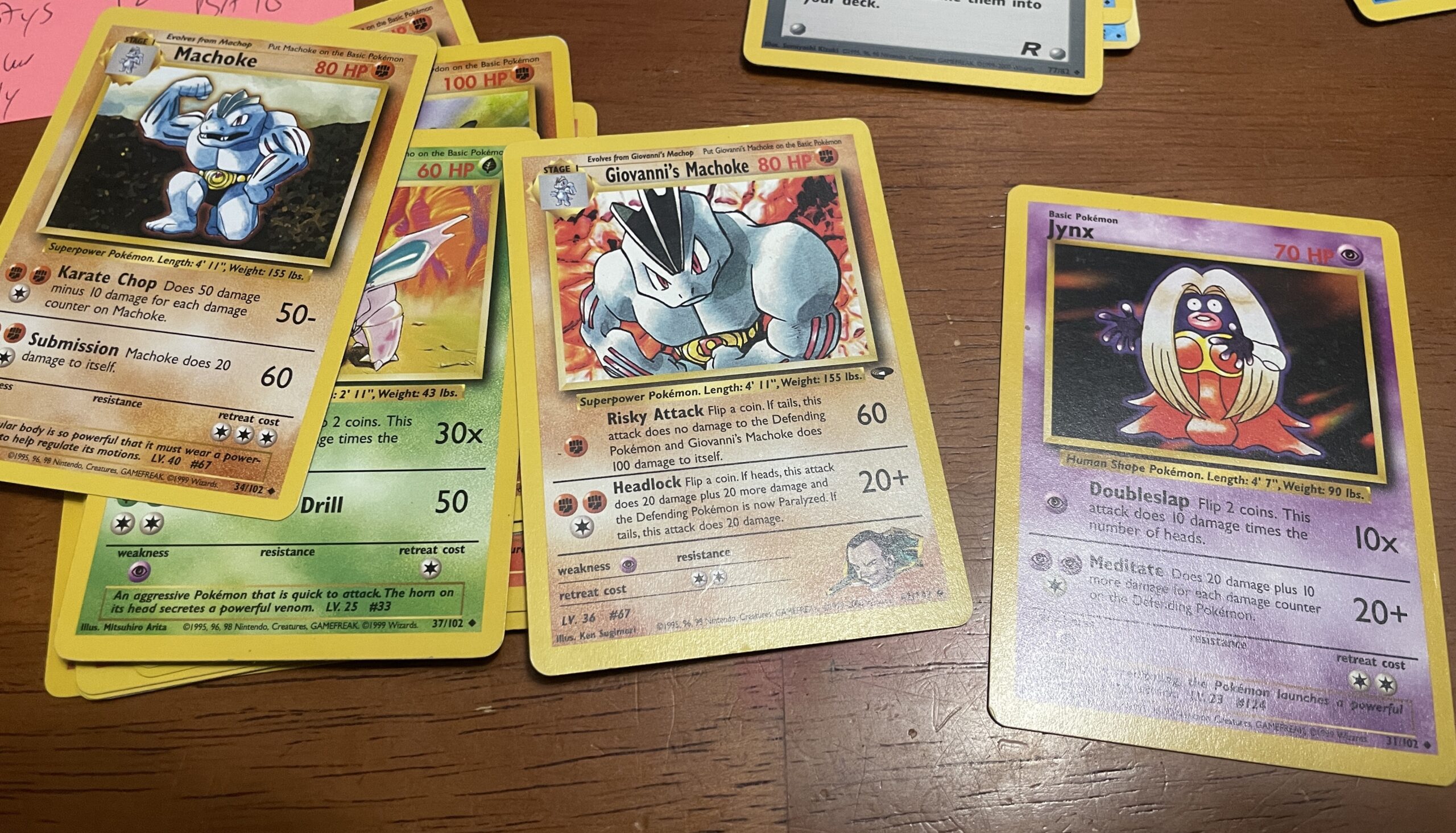Ah Yes – Gotta catch ’em all
I’m a 90’s kid. I grew up when Pokémon was big and it was really an international phenomenon. I had the trading cards, the Gameboy games (had a level 100 Blastoise – it was a big deal), watched the original show on the weekends, and even use to draw the Pokémon into my own little scribbling notebook! I was pretty much obsessed. Fast forward to present day where I’ve moved once (and lost a few really high value cards) and found the remaining cards to sell at a profit. It’s been much more of an involved process than I originally thought, but it seems that I do have a few cards that can turn a profit.

I Had To Try Again
Before my move to Florida I had a full binder of like new cards (the trading community calls these Near Mint or Gem Mint – here’s a grading scale). I’m talking about cards that are going for $10,000+ in the market right now. Instead of doing research I threw them on eBay and got messaged from a legitimate collector letting me know that I was selling at graded prices without getting the cards graded. After he educated me on this I decided it wasn’t worth it and eventually lost the cards in the move. I still am beating myself up over that move. After years had passed, I came across another set of cards after I saw my friend sell a few of his for a nice amount. This time around I did the research on the values, spent time sorting all the cards, and then submitted them to get graded all in hopes of making a profit.

So Where Did I start
First things first – people collect a lot of different cards. Sports cards, Pokémon cards, Magic cards, and more. Then there are even different categories to each (I’ve got a promotional Pokémon card and a bunch of Trading Cards). Since there is demand for collecting these cards, the value will go up on them depending on the condition and demand. There is a value for the ‘Raw’ cards pending it’s condition and then there are values for graded cards (which are MUCH higher). But who does the grading?
There are two well known official grading companies Certified Guaranty Company (CGC) and Professional Sports Authenticator (PSA). There is also Beckett Grading Services (BGS), but I didn’t see BGS in much of my research. Out of the three PSA seems to be the most well known and the one I ended up going with to grade my cards. They also have a very clean way of getting them to auction OR back to me to sell on places like eBay. While the process does take some time to prepare and ship to PSA it’s worth it if you have valuable cards. The best known spots for selling that I’ve seen is eBay or Goldin Auctions for PSA Collectables (both of which buyers can still verify the legitimacy of the graded card).
After I figured out where I was going to sell them (to a degree), knew where I was going to get them graded, I just needed to do the research on how much each card was really worth.
![]()

My Process To Profit (Hopefully)
Start with the people who have done this before. I asked a few of my friends who had done this process before and did a little Googling. Where could I do research on the cards and get an accurate estimate of value once graded. After getting some suggestions I used pricecharting.com, Pokedata.io, and the PSA App. I also used tcgplayer.com to find my ‘quick glance’ check on how rare a card was. I did find that the PSA App was pretty fair in estimates (they say estimate because it’s not an appraisal and it’s based on market sales and fluctuations). Pokedata had higher values in most cases and pricecharting was closer to the PSA App estimate. As you can see in the image above I used the average to value the cards, but when I submitted I used the PSA App estimate.
Step 1: I researched what made certain cards rarer than others. The easiest for me was looking for the 1999 to 2000s cards. There were some easy ways to tell at a quick glance since I had over 450 cards to sort through that can be found here. TL;DR:
– Bottom right on a card has a star, diamond, or circle – from left to right is the most rare to least rare.
– 1999-2000 cards at the bottom in text are typically of higher value.
– First edition, ‘shadowless’ (no shadow behind the image), and specific versions like fossil or Jungle are of higher value.
Step 2: Once I sorted all my cards into Rare, Uncommon, and Common I looked through the condition of each. If they had a good chance of getting a PSA 9 or 10 I put them into a pile and logged in my Google Sheet. The rest that weren’t really in a good condition I placed back into an organized binder.
Step 3: After sorting I started to do some more research into what was going to be needed for shipping to PSA. PSA has a list of what you would need to ship and recommendations on how to ship (I read that about 3 times and called in a few times). I ended up ordering things off of Amazon including mylar sleeves, harder card covers, and bubble wrap. I also took note of the cost for each ‘submission’ to PSA, the potential shipping cost, shipping insurance, and any additional fees.

Step 5: I trimmed down the card deck to 70 cards and used the sites I mentioned above to figure out the highs, lows, and average value of the card. I looked at the ungraded value as well as the value at a PSA 8, 9, and 10. While looking through these cards I was placing them in the Google sheet (dividing them into under $200 and over $200 since that was the biggest difference in service price) and taking note of the condition of the cards. At the same time I was using the PSA App to start taking pictures of all of the cards and getting them prepared for submission by declaring an estimated value and the service level (that includes turnaround time and insurance).

Step 6: At this point I reviewed the cards once more and created a new tab for my first submission. After reviewing the condition of the cards I selected, I cut it down to 50 making a bet that they would be the ones that would come in at PSA 8 or higher. I also bought 6 cards that would be worth a good amount if graded high enough and the raw price wasn’t too wild (except for the Dark Charizard which cost $137).
Step 7: I then placed each card in its own soft sleeve and a slightly more rigid holder. I created four different submissions (each had a different service level) and then paid for everything. Once the order was created I printed out each submission form and carefully followed how to pack up the box. I went with USPS and made sure I had the express delivery to have less time in transit (and I got it refunded because it actually took two days).
Step 8: I watched my cards arrive, get into the queue and even had one make it through to assembly within a few days.
Step 9: Sell them and profit. This one I’m not at yet, but will provide all the numbers when I’m there.

The Beginning of New Income
Start Depending on how this first batch goes I might make this more of a regular flipping process. Take a note out of Gary Vee’s book and check it out. There are more options than just Pokémon cards too – Sports cards and memorabilia also hold value.



